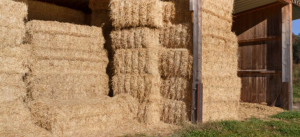 Cultivating good-quality hay is no easy task and is dependent on cooperative weather for optimal success. Hay farmers must keep a keen eye on plant growth, the moisture content at harvest, and other baling considerations in order to avoid moldy hay for horses. Mold forms on hay because of excessive moisture, which is why it is so critical to harvest hay under the most conducive conditions and then store it properly once baled.
Cultivating good-quality hay is no easy task and is dependent on cooperative weather for optimal success. Hay farmers must keep a keen eye on plant growth, the moisture content at harvest, and other baling considerations in order to avoid moldy hay for horses. Mold forms on hay because of excessive moisture, which is why it is so critical to harvest hay under the most conducive conditions and then store it properly once baled.
Moisture content is a crucial measure when it comes to hay production. Once hay is cut in the field, it needs to dry. Length of drying time varies based on geographical region and weather. Humidity or rain will slow this process, leaving the crop vulnerable to mold and fungus. If hay is baled at 12-14% moisture or less, the likelihood of mold is reduced.
If a preservative is not used on cut hay, mold will grow if moisture concentration above about 14%-15%. In addition to nutrient loss, mold growth produces heat. If moldy hay is stored in tight stacks or in areas of poor ventilation, there is a risk for spontaneous combustion. For this reason, all hay should be stacked in well-ventilated areas, with an alternating pattern that allows airflow between bales.
Common molds that grow on hay include Aspergillus, Fusarium, Penicillium, and Rhizopus, among others. Molds generate spores that can irritate respiratory tissues, contributing to recurrent airway obstruction (RAO), also known as heaves. RAO can lead to impaired performance due to difficulty breathing. Special attention should be given to the hay being fed to a horse who already suffers from RAO to avoid additional complications. Moldy hay can also cause colic.
Botulism is a concern for horses consuming hay, particularly large round bales. If animals or carcasses of small animals, such as mice, are caught up in the bale during harvesting, they can infect the hay with Clostridium botulinum bacteria as they decay. Contaminated hay can cause illness to the horse that consumes it. Symptoms of botulism in horses include weakness, muscle tremors, inability to swallow, loss of muscle tone in the tail, paralysis, and incoordination. Horses left untreated for or severely affected by botulism may die if the bacteria paralyze the respiratory system. Ask your vet about the botulism vaccine if your horse consumes round bales.
Proper storage is a critical component of hay-feeding. “Hay should be stored in a dry, well-ventilated area off of the ground,” advised Kathleen Crandell, Ph.D., a nutritionist with Kentucky Equine Research. “Avoid placing tarps tightly around hay, which will prevent moisture from escaping. Don’t stack hay too high, and be sure to leave some space between each bale to allow for airflow.” These techniques will help minimize the risk of mold growth in hay.
Further, no matter which variety or cutting of hay you have in the barn, take the time to inspect it prior to feeding. Hay may look perfectly fine on the outside, but it is possible for mold to be growing on the inside, according to Crandell.
While mold may be difficult to detect visually, an unusual odor usually accompanies mold growth. If hay is dusty or smells musty, do not feed it. Any black or gray mold is a sure sign of spoiled hay and potential health risk to the horse. Work with your hay supplier to replace unsuitable hay bales, and talk to your veterinarian about preventative measures for maintaining the horse’s health.
Hay is a staple in the diets of many horses. For those horses that do not receive a commercial fortified concentrate with their hay, owners should consider a vitamin and mineral supplement, such as Micro-Max (Gold Pellet, Nutrequin, or Perform in Australia). A well-formulated vitamin and mineral supplement will round out the nutritional needs of horses on all-forage diets. “The use of a vitamin and mineral supplement or a ration balancer to fill in the nutritional gaps formed by feeding only pasture or hay is an easy, though oft overlooked, management strategy that ensures optimal health,” said Crandell.
Would you like more information about switching to hay diets? Contact us at J & J Farms by clicking here!
Article brought to you by KER.
